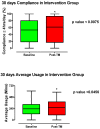The Effect of Telemonitoring (TM) on Improving Adherence with Continuous Positive Airway Pressure (CPAP) in Obstructive Sleep Apnoea (OSA): A Service Improvement Project (SIP)
- PMID: 35326943
- PMCID: PMC8951405
- DOI: 10.3390/healthcare10030465
The Effect of Telemonitoring (TM) on Improving Adherence with Continuous Positive Airway Pressure (CPAP) in Obstructive Sleep Apnoea (OSA): A Service Improvement Project (SIP)
Abstract
The benefits of CPAP demonstrated in clinical trials are difficult to deliver in real life due to the lack of adherence. We analysed the effect of a Telemonitoring (TM)-related intervention on adherence as part of a Service Improvement Project (SIP) analysed as a retrospective cohort study. The 'historical control' (HC) cohort (followed up in conventional clinics) included all patients who commenced on CPAP between 1 February and 30 April 2019 (n = 142). The 'telemonitoring' (TM) cohort included all patients who commenced on CPAP between 1 May and 31 July 2019 (n = 166). Adherence was checked at 30 days (baseline) and 73 days for both cohorts. Wilcoxon-Rank test was used for statistical analysis (results reported as mean ± SEM). Both cohorts had similar adherence at the 30-day baseline, compared to a significantly lower adherence in the HC-cohort at 73 days (55.7 ± 3.0 vs. 51.8 ± 3.2% of days ≥ 4 h: p = 0.0072, average usage 255 ± 12.8 vs. 236 ± 13.7 min: p = 0.0003). There was a significantly higher adherence in the TM-cohort at 73 days (50.8 ± 2.5 vs. 56.1 ± 2.9% of days ≥ 4 h: p = 0.0075; average usage 234 ± 10.4 vs. 252 ± 12.1 min: p = 0.0456). Telemonitoring-feedback is effective at improving adherence with CPAP, suggesting its potential beneficial role in the community setting, particularly in the post-COVID reality of increased remote consultations.
Keywords: CPAP; OSA; adherence; telemonitoring.
Conflict of interest statement
The authors declare no conflict of interest.
Figures




References
LinkOut - more resources
Full Text Sources
Miscellaneous

